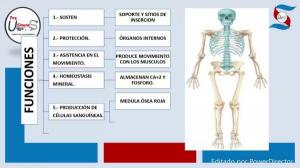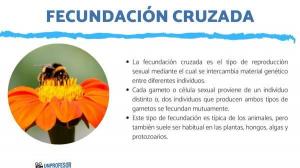What are the sesamoid BONES

Did you know that in our skeleton there are some bones so small that its name refers to the tiny sesame seed? They are the so-called sesamoid bones. In this lesson from a TEACHER we show you what are the sesamoid bones, where they are located and their important contribution to the movement of some parts of the body.
Index
- What are sesamoid bones?
- Sesamoid bones of the foot
- Sesamoid bones of the hand
- Sesamoid bone of the knee: the patella
- Sesamoid bone pathology: Sesamoiditis
What are sesamoid bones?
The skeleton is made up of several types of bones, which are classified according to their shape, distinguishing four large groups: long bones, flat bones, short bones and irregular bones.
The sesamoid bones they are a type of short bone (cubic shape) specialized. They get their name from their small size, like that of sesame seeds. These small bones were not described until the 17th century. It is about bones that in some cases they are fickle
In other words, they do not always appear in all individuals. Meanwhile in others are constant, that is, they occur in all individuals. Constant sesamoid bones are those that appear in the first joint of the big toe or the patella or patella, in the knee.These types of bones are formed inside the tendons and its function is to strengthen tendons and improve muscle traction mechanics or the associated muscle group. That is, they act as a pulley and intervene in the movement. They are located in the tendons of the feet and hands and contribute significantly to their movement. However, the largest sesamoid bone is located in the knee joint and is called the patella. Some sesamoid bones are located in the vicinity of some joints.
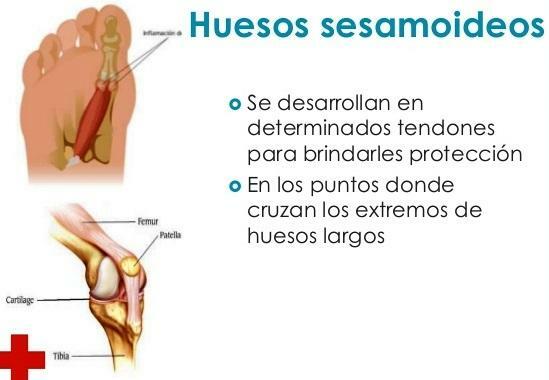
Sesamoid bones of the foot.
This set of bones does not appear in a fixed number, they are located in the joints of the toes., associated with plantar flexor tendons. The plantar flexor tendons are what allow the toes to flex. These are bones that receive little irrigation and suffer necrosis (tissue death due to lack of blood supply) with some ease due to injuries due to overuse or trauma.
The most frequent are those of the metatarsophalangeal joint (the joint between the metatarsal and the first phalanx), in the area of the sole of the foot. In the case of the first finger (thumb") there are two sesamoid bones in the first crescent-shaped joint that lie inside the plantar flexor of the finger; they are constant bones (they are present in all individuals). In some cases sesamoid bones also appear in joints between the middle and distal phalanx.
The sesamoid bones of the foot, especially those of the big toe, in addition to protecting the flexor tendons, have a important role in cushioning body weight and absorbing shock of the foot against the ground during the march or in the reception of the jump.
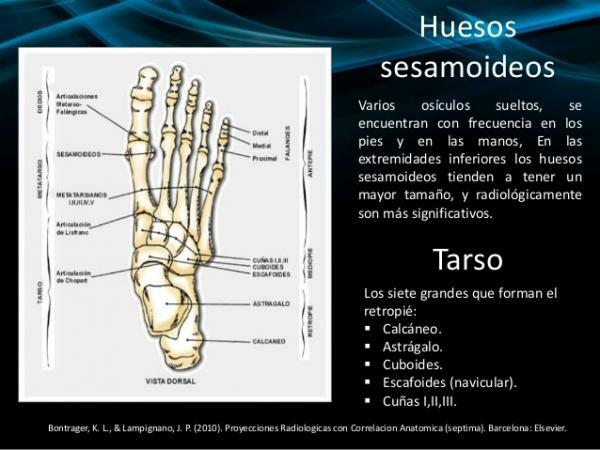
Sesamoid bones of the hand.
As in the sesamoid bones of the foot, the sesamoid bones of the hands can vary in number and location in people. The most common sesamoid bones in the hand are located in the palmar (palm of the hand) region of the first joint of the thumb (metacarpophalangeal joint). These two ossicles are constant. That is, they are present in all individuals.
However, they can also be found, fickle sesamoid bones in the metacarpophalanphic joints of the index finger and little finger; and less frequently in the metacarpophalangeal joint of the ring and middle fingers, and in the interphalangeal joint (between the first and second phalanx) thumb.
In addition to the sesamoid bones of the fingers, a sesamoid bone in the wrist joint. Specifically, the pisiform bone (pea-shaped) is located superimposed on the pyramidal bone (bone that is part of the carpus of the hand).

Sesamoid bone of the knee: the patella.
Although most sesamoid bones are located in the hands and feet, and are bony and small in size, there is an important exception: the patella. The kneecap or patella is the larger sesamoid bone and is located in the anterior (front) area of the knee joint. It develops inside the tendon of the quadriceps muscle. This bone is shaped like an irregular triangle, with two faces.
The main function of the kneecap is to increase the effectiveness of the quadriceps, in the same way as a pulley; in addition, to decrease the friction of the tendon.
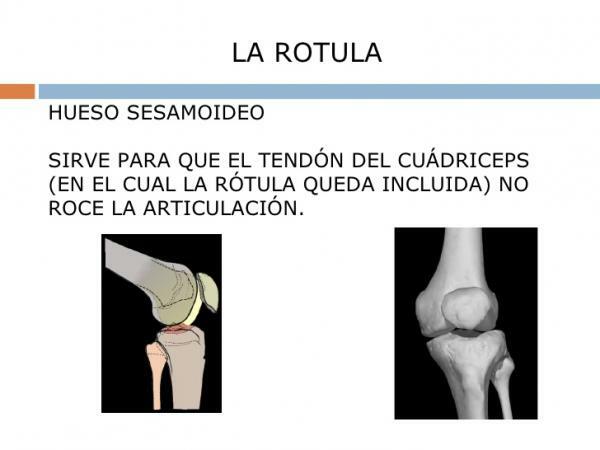
Sesamoid bone pathology: Sesamoiditis.
Sesamoiditis is a painful inflammatory process, produced by an injury to the sesamoid bones that consists of inflammation of the tendon-related structures in the area in contact with the sesamoid bone. It is more common in adolescents and young adults. In addition to pain, sesamoiditis can cause stiffness of the affected area and crepitus (noise or sensation of noise with movement).
The most common sesamoiditis is that of the big toe. This inflammation occurs from chronic repetitive stress, that is, a repeated overload when running or jumping; due to excessive exercise or repetitive movements. In the absence of repeated trauma, sesamoiditis can also be caused by infection or processes of osteoarthritis or arthritis of the sesamoid bone.
If you want to read more articles similar to What are sesamoid bones, we recommend that you enter our category of biology.
Bibliography
Netter, Frank H. (2019). Atlas of Human Anatomy - 7th Edition Barcelona: Elsevier España, S.L.U.

